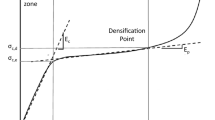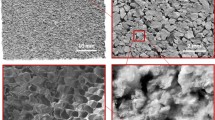Abstract
Cork is a natural cellular material with increasing industrial applications due to its remarkable combination of properties. Its mechanical behaviour explains why it is often used for applications like sealing, packaging, insulation, vibration control, weight reduction, flotation, sound damping, etc. However, the mechanical behaviour of cork when subjected to impact has not been well investigated yet since the studies described in the literature generally focus strain rates below 10−1 s−1. Understanding the behaviour of cork at high rates of deformation becomes imperative when considering applications such as crash protection. Hence, in the present work, the authors compare the quasi-static and dynamic response of four types of cork when compressed axially at strain rates from 10−3 s−1 to 600 s−1. Data from the Split-Hopkinson Pressure Bars are used to generate stress–strain curves for natural and agglomerate cork samples, and the results are discussed in terms of the cellular structure of cork.










Similar content being viewed by others
References
Gibson LJ, Ashby MF (1997) Cellular solids: structure and properties. Cambridge University Press, Cambridge, UK
Deshpande VS, Fleck NA (2000) Int J Impact Engng 24:277
Paul A, Ramamurty U (2000) Mat Sci Eng A Struct A281:1
Santosa P, Wierzbicki T, Hanssen AG, Langseth M (2000) Int J Impact Engng 24:509
Fortes MA, Rosa ME, Pereira H (2004) A Cortiça. IST Press, Lisboa
Anjos O, Pina P, Rosa ME (1997) In: Proceedings of European conference on cork oak and cork. Centro de Estudos Florestais—Instituto Superior de Agronomia, Lisboa, p 317
Fortes MA, Nogueira MT (1989) Mat Sci Eng A Struct A122:227
Gibson LJ, Easterling KE, Ashby MF (1981) Proc R Soc Lond A377:99
Hopkinson B (1914) Phil Trans R Soc Lond A213:437
Kolsky H (1949) Proc R Soc Lond B 62:676
Gary G (2001) In: Nowacki WK, Klepaczko JR (eds) Trends in mechanics of materials, vol 3, Poland, p 179
Pochhammer L (1876) J für die Reine Angewandte Mathematik 81:324
Chree C (1889) Cambridge Phil Soc 14:250
Zhao H, Gary G, Klepaczko JR (1997) Int J Impact Engng 19:310
Klintworth JW (1989) Dynamic crushing of cellular solids (PhD Thesis, Department of Engineering, University of Cambridge
Acknowledgements
The authors are grateful to the Portuguese Foundation for Science and Technology (FCT) who financially supported this work, through the Program POCTI/35907/EME/2000 (Portuguese Government and FEDER) and SFRH/BD/18964/2004, and to ROCAP for providing the cork samples.
Author information
Authors and Affiliations
Corresponding author
Rights and permissions
About this article
Cite this article
Gameiro, C.P., Cirne, J. & Gary, G. Experimental study of the quasi-static and dynamic behaviour of cork under compressive loading. J Mater Sci 42, 4316–4324 (2007). https://doi.org/10.1007/s10853-006-0675-6
Received:
Accepted:
Published:
Issue Date:
DOI: https://doi.org/10.1007/s10853-006-0675-6




